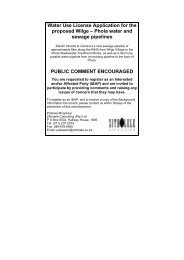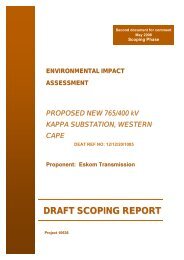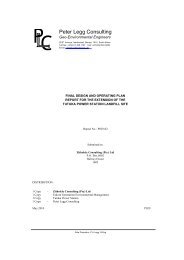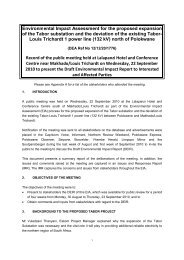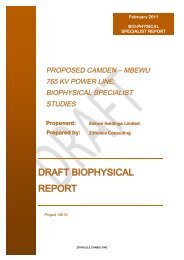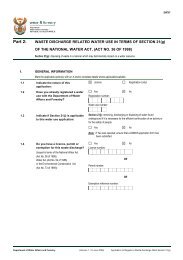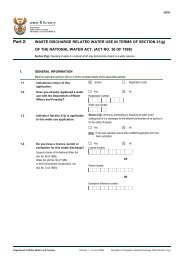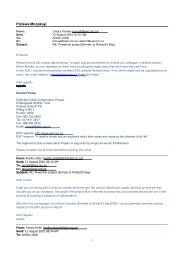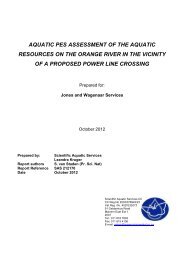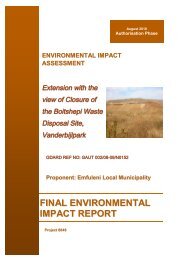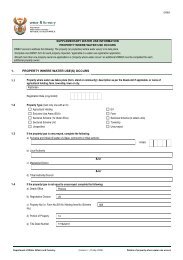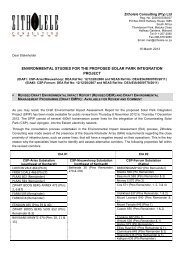Draft Basic Assessment Report.pdf - Zitholele.co.za
Draft Basic Assessment Report.pdf - Zitholele.co.za
Draft Basic Assessment Report.pdf - Zitholele.co.za
Create successful ePaper yourself
Turn your PDF publications into a flip-book with our unique Google optimized e-Paper software.
BASIC ASSESSMENT REPORT<br />
3. ENVIRONMENTAL IMPACT STATEMENT<br />
Taking the assessment of potential impacts into ac<strong>co</strong>unt, please provide an environmental impact<br />
statement that summarises the impact that the proposed activity and its alternatives may have on the<br />
environment after the management and mitigation of impacts have been taken into ac<strong>co</strong>unt, with<br />
specific reference to types of impact, duration of impacts, likelihood of potential impacts actually<br />
occurring and the significance of impacts.<br />
Alternative A (preferred alternative)<br />
After <strong>co</strong>nsidering the proposed project (FFP retrofit at Unit 4) and the associated<br />
impacts (<strong>co</strong>nstruction noise, improved air quality, short term job opportunities,<br />
<strong>co</strong>mpliance with 2020 Minimum Emission Standards) it is the view of this Environmental<br />
<strong>Assessment</strong> Practitioner that the positive impacts of this project outweigh the potential<br />
negative impacts that this project can have.<br />
The existing site is a brownfields operation with existing buildings and infrastructure<br />
and paving <strong>co</strong>vering the whole site. There are no environmental sensitivities near the<br />
site and there are procedures in place to ensure that any potential impact is avoided or<br />
prevented. The station currently operates 3 highly successful FFP’s and retrofitting Unit<br />
4 will further improve their operations.<br />
If the retrofit is approved during this unplanned downtime period, the planned retrofit of<br />
2017 will be brought forward 6 years, ensuring the that current operations are operating<br />
within the emission limits of 2020 as early as 2012.<br />
It is re<strong>co</strong>mmended that the preferred technology (FFP) be approved for the proposed<br />
retrofit at Unit 4, using this ideal timeframe when the unit is not operational and no<br />
further stress will be placed on the power supply of the <strong>co</strong>untry.<br />
No-go alternative (<strong>co</strong>mpulsory)<br />
The existing technology is reducing the impacts from the raw emissions (30 000 – 50 000<br />
mg/Nm 3 without ESP to 104 mg/Nm 3 with ESP) from the boilers, however this reduction<br />
is not efficient enough to allow the station to <strong>co</strong>nform to the emission standards set by<br />
DEA in their emissions license (75 mg/Nm 3 ). In addition future standards (2012 – 50<br />
mg/Nm 3 ) will be even more stringent. Efforts to <strong>co</strong>nform to these standards without<br />
changing technology can negatively impact on operations as there is a risk of load loss.<br />
As shown in the site photos and the air quality report, the FFP technology is the better<br />
technology to utilise for this purpose, especially when taking the long term air quality<br />
standards into <strong>co</strong>nsideration and hence the no-go alternative should not be <strong>co</strong>nsidered.<br />
28



